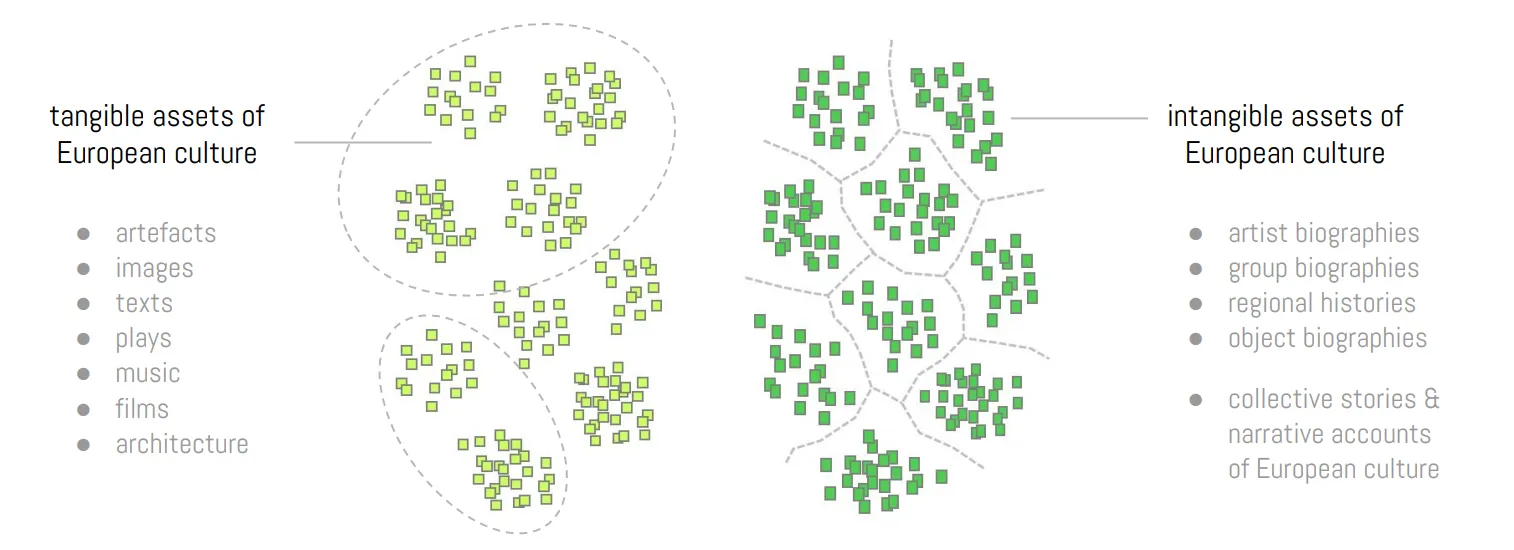
Overall Aims
Representations of tangible objects of European cultural heritage (such as images, texts, music, films, buildings, or artifacts) have been digitized and aggregated widely. Up to the present day, the focus of digitization has been on the core of these objects, i.e. their visual appearance (captured by photographs, 3D scans, or AV files) and on the documentation of structural information (multiple metadata dimensions, such as time and place of origin, creator, genre, content, etc.). As a consequence, a plethora of object databases have emerged, which allow experts and public audiences to access an unprecedented amount of cultural assets—regardless of the collection's original location, opening hours, or entry fees—with a stunning degree of detail.
However, from a historiographic point of view, cultural heritage objects appear as rather atomized entities on visitors' screens (Fig. 1, left). Despite various options provided by linked data initiatives, most interfaces to cultural collections present tangible assets stripped from their cultural and historical embeddings in a decontextualized fashion (Windhager et al., 2019, p. 2325). We see a real need to overcome this state of affairs and to reconnect tangible objects with related intangible (hi)stories and with their socio-cultural background, to provide audiences with a more comprehensive understanding of historical objects, and to facilitate their situated, sensible, critical, and hermeneutical interpretation. As the needs of different audiences vary, this contextualization should satisfy various scholarly and practical, but also narrative and aesthetic demands.

Figure 1. Partially aggregated tangible asset collections (left) and intangible assets (such as cultural (hi)stories, right) have been digitized, organized and presented separately, without utilization of synergies on many levels.
As a key to this endeavor, we turn to national biographical databases across Europe (Fig. 1, right). Biographical lexicons and biographical data are invaluable sources for historical research as they provide us with essential information on thousands of historical figures, which are closely connected to cultural heritage objects: from the cultural heroes of a nation to the many thousands of other significant, yet lesser-known figures who were influential in domains such as the arts, politics, humanities, or natural sciences. Their historical life paths can provide crucial context for tangible heritage objects, which have been created, owned, or influenced by historical actors, or which are depicting and referring to them. The events of individual biographies can further be aggregated into (histories of) larger contextual composites: groups (e.g. guilds, family histories), institutions (e.g. art schools, universities, religious orders, political movements, companies) and regional entities—from cities to whole countries. InTaVia will draw these types of assets together to allow their integrated exploration, analysis, and curation for cultural heritage experts. To share this new type of in/tangible knowledge with public audiences, InTaVia will build on the use of stories, which are known to be an essential and engaging mode, not only of human communication—but also of thinking (Mayr & Windhager, 2019; Riche et al., 2018).
InTaVia will assemble twelve national biography projects—including four biographical databases developed or enhanced by project partners (FI, NL, AT, SI), and eight projects associated with declarations of intent (BE, CZ, DE, HR, HU, UK, CH, AU).[1] This corpus will contain well over 250.000 biographies of people—mainly from the 17th to the 20th century—across Europe and beyond. While this integration and harmonization of national biography databases will already constitute an eminent resource for historical research (to study transnational historiographical questions), the main aim of the project is the interconnection of these intangible assets with the rich and tangible objects of several large object databases: different museums (e.g., art, science & technology, war, literature) and libraries are associated with declarations of intent, as well as the aggregators Europeana and prometheus.
The fusion of data from object and biographical databases—resulting in an integrated, 'object-oriented biographical database'—will help to answer new questions across the tangible/intangible data divide and will support new curation, communication, and promotion practices.
- With respect to this new kind of object-biography-data, InTaVia will investigate how to contextualize tangible cultural heritage objects with intangible biographical and historiographical data on various levels of aggregation. How can events of individual biographies (e.g. activities of artists) contextualize the collected works of these individuals? How can such 'object-oriented' biographies themselves be contextualized in larger biographical histories (of groups, institutions and regions)? How can we visually analyze the patterns within such composites, to better study the cultural dynamics and histories of institutions or cities? How can we develop visual storytelling methods to communicate these in/tangible cultural riches to non-expert audiences in aesthetically pleasing and engaging ways?
- The project's focus on the creation of a hybrid working environment for object-biography-data will unlock two lines of inquiry whose relevance can hardly be underestimated. Many analysis and curation tools for object-biography-data will also be applicable to pure object and pure biography data. The InTaVia platform thus will facilitate the analysis and presentation of pure object corpora with various VA perspectives on close and distant viewing levels, including transnational and comparative views. Similarly, pure biographical data will become visually accessible and analyzable—from individual biographies to the composite biographies and (hi)stories of groups, institutions, and regional entities.
- Regarding the intended syntheses, we will examine how to enable and foster the ongoing curation of these in/tangible knowledge collections, to continuously enrich and interconnect the (hi)stories, perspectives and experiences of European actors, networks, and regions. We will explore and demonstrate how to create new structured data from heterogeneous historical language sources, and deal with the wide variation in style, structure and language use found in historical texts, storing such intangible (hi)stories. We will deliver tools to visually support data creation and curation.
- In addition, InTaVia will explore how to raise Digital Humanities tools onto a next level, where they become intelligent agents that can contribute to the discovery of new research questions and interesting patterns of data, using strategies of 'serendipitous knowledge discovery' (Hyvönen, 2020).
The InTaVia project will develop data and technologies to make these inquiries possible. In particular, we will (i) harmonize biographical data models and combine data from national institutions, (ii) develop an integrated 'object-oriented' prosopographical data model to combine intangible natural language data and tangible object data, and iii) advance text mining methods to dynamically create more structured data from different historiographical texts. InTaVia will further (iv) provide access to the object-biography-database (and thus also biographical and object databases) data through interactive, visual representations (“VA studio”) for cultural heritage scholars and practitioners to synthesize and analyze in/tangible data. In a complementary fashion, we will (v) develop methods to create narrative visualizations for the presentation and promotion of object-biography- ata to non-expert audiences (“visual storytelling suite”), and we will (vi) provide visual support for data curation and creation. As for an overall strategy, InTaVia will (vii) involve all user groups (cultural heritage scholars, historians, curators, practitioners, teachers, promoters, interested public) to ensure the data and tools meet their requirements.
The outlined research endeavor is motivated by a unique historical and technological constellation, in which new forms of digital content allow—but also require—the development of new interfaces for more effective and engaging access to in/tangible cultural assets. Individual institutions have made significant progress in digitizing, enriching, and visualizing data for their own domains. InTaVia brings related expertise together to combine insights from researchers with roots in biographical research, semantic web research, natural language processing, visual analytics, human-computer-interaction, and cognitive science. As such, InTaVia not only extends the state of the art in digital humanities and cultural heritage practice and research, but also investigates implications for adjacent knowledge domains, dealing with similar data characteristics.
References:
Hyvönen, E. (2020). Using the Semantic Web in digital humanities: Shift from data publishing to data-analysis and serendipitous knowledge discovery. Semantic Web, 11(1), 187–193. https://doi.org/10/ggp7k4
Mayr, E., & Windhager, F. (2018). Once upon a Spacetime: Visual Storytelling in Cognitive and Geotemporal Information Spaces. ISPRS International Journal of Geo-Information, 7(3), 96. https://doi.org/10/gdqvqt
Windhager, F., Federico, P., Schreder, G., Glinka, K., Dörk, M., Miksch, S., & Mayr, E. (2018). Visualization of cultural heritage collection data: State of the art and future challenges. IEEE Transactions on Visualization and Computer Graphics, 25(6), 2311–2330. https://doi.org/10/gfj32f
Riche, N. H., Hurter, C., Diakopoulos, N., & Carpendale, S. (2018). Data-Driven Storytelling. AK Peters, Ltd.